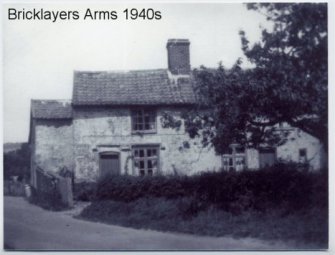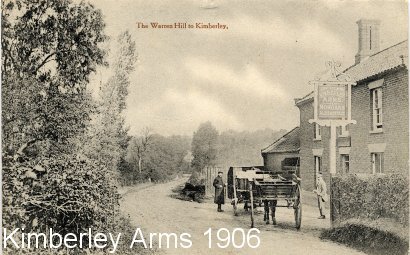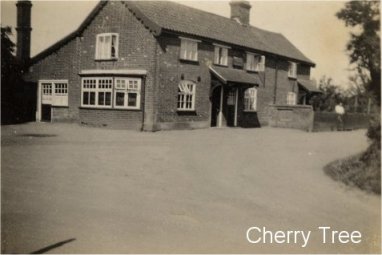There was a Public Dinner, Sports and Dancing. Beer tickets were issued to avoid unfairness, but human nature being what it is these were not used properly and some got more and some less of their share. In February 1898, the Vicar took a break and wrote to his flock describing a voyage through the Bay of Biscay, where there were cows and chickens on board, so fresh milk and eggs were available. There was also electric light (electricity came to the villages in 1933.) He was heading for Ascension Island, St. Helena and South Africa. On his return he took a party to the Missionary Loan Exhibition in a special reserved railway carriage from Kimberley station.
Crownthorpe
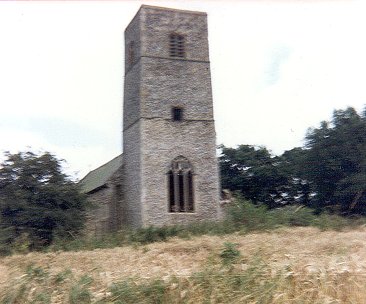
Crownthorpe lies to the east of Wicklewood and was once a separate parish. The church is now ruinous. Recently some fieldwork has brought to light a Roman settlement on a Roman road from Denver to Caistor (Venta Icenorum).
Second century Roman military equipment was also found although the legions were not then based in this area.
During the First World War a British plane crashed in a cornfield and a bomb landed near St. George’s School. There were two brothers who made top quality boots, a baker, butcher, blacksmith and a carpenter. There was a post office in the village.
My grandfather went to live in Wicklewood when he was two years old, in 1907, and lived in a thatched cottage. In 1912 there was a bad flood and a boy and several cows were drowned. The first motor in the village was a privately owned bus and it provided the first service. There were four public houses called The Wild Man, Kimberley Arms, Brickmakers’ Arms and the Cherry Tree. Only the last remains. The mill was worked by a father and two sons and the miller could be seen milling at night in his nightgown if the wind was strong! Anon
We interviewed (by whom and when unknown -TE) Cissy Buck who is 80 years old and has lived in Hackford for 75 years. She lives in a house, built in 1866, that used to be a shop until about three months ago. Cissy’s family had owned the shop for 80 years. In the past there was no electricity and they obtained water from a well in her garden. The roads were narrow and made of stone and earth. The first person to own a car was Mr. Watling. Work was associated with agriculture, such as horsemen and cowmen. There was also a blacksmith. She attended Wicklewood School which had strict teachers, and left at14 years of age. There were two public houses in the village called King’s Head and Red Lion. A bomb dropped near the church. War time evacuees left after the war.
The Village at War
In January 1900, the Norfolk Regiment went to the Boer War, with two Wicklewood men amongst them. Five years later, John Saunders was in the Russo-Japanese war.
In January 1916 a bomb dropped on George Breeze's allotment. The Germans thought that Wicklewood Workhouse was a barracks they mis-aimed.
The Home Guards' duty in World War Two was to protect the waterworks. There was a searchlight site at the Vicarage Farm, and three bombs were dropped on what was Mr Chasten's land in Green Lane. Local Government
In 1896 it was the duty of the District Council (Forehoe and Hempstead) to test drinking water much of which came from wells in people's gardens, inspect dustbins and improve roads. Roadmen, known as 'Lengthmen' were employed to keep a certain length of road in good repair. They would be seen working along the roads with their barrows and shovels Mr. Defew, who was killed in the First World War, was one of these, Billy Allen was the last - he died in at 1988. in 1899 the County Council sent a horse shoeing training van round the village. Village Sign
The Parish Council decided to erect a village sign to commemorate Queen Elizabeth’s Silver Jubilee in 1977. There was a competition for the best design and these were displayed in the village hall on Silver Jubilee Day.
The winner at that time lived on the Hackford road. The sign depicted the mill and a horse ploughing.
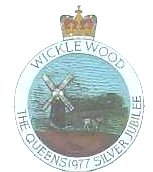
It was unveiled by Basil Cook; Chairman of the Parish Council., the garden surrounding it is maintained by the Wicklewood Guides.
Notable Village landmarks
1841 National school in churchyard built. Demolished 1895
1897 Parish room erected.
1900 Four public houses, Cherry Tree, Wild Man, Bricklayers Arms and Kimberley Arms.
1902 New church gate and turnstile made by Mr Buck
1903 Wade’s butcher shop opened.
1904 Village Hall being built. Parish Room had become too small. Opened Oct 5th Architect – Boardman. Builder – Larner of Dereham.
1908 Two Primitive Methodist Chapels existed.
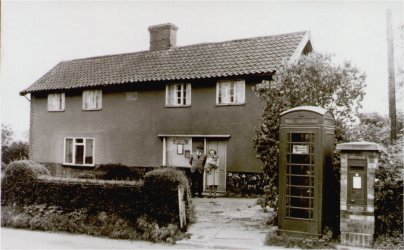 The Post Office 1960's
The Post Office 1960's
